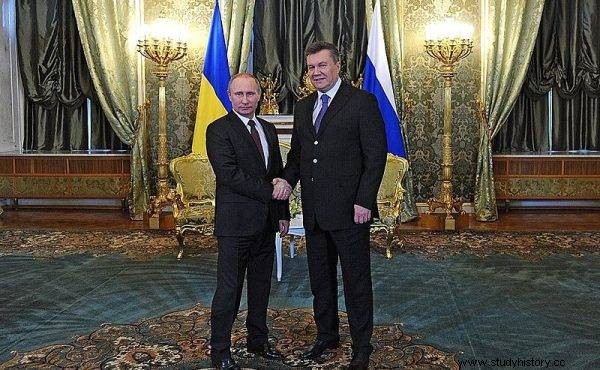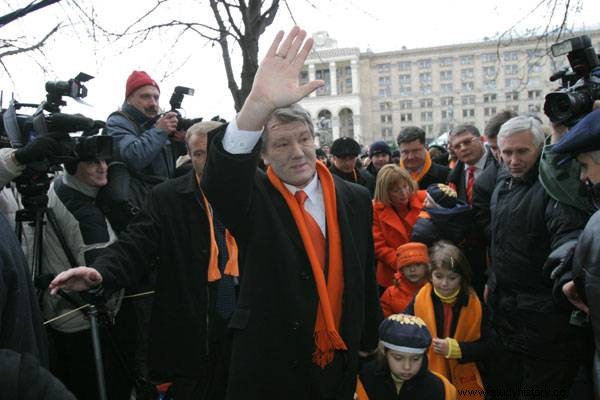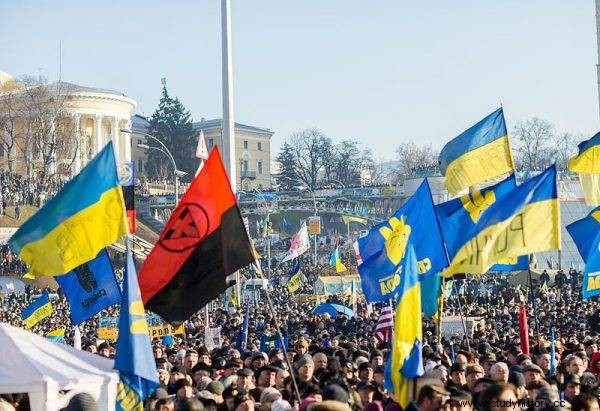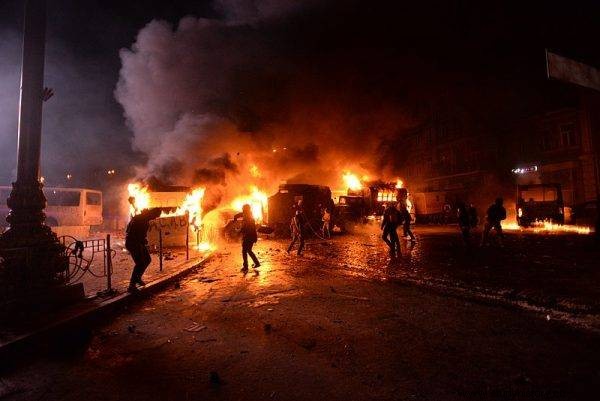The Maidans of 2004 and 2013–2014 are turning points in the history of Ukraine. Two waves of nationwide protests were starting to shape civil society.
Where did the name "Majdan" come from? It comes from "Maidan Nezaleznosti", i.e. Independence Square in Kiev . It is a place where citizens who were dissatisfied with the actions of the authorities gathered. This provoked protests across the country. The Maidans were stigmatized in Russia. Why? As writer Borys Akunin stated:" the success of the protesters could suggest to the Russians that citizens are able to influence the rulers and the way they govern" .
From the election…
The beginning of the first Ukrainian Maidan was the rigged results of the presidential election which took place on November 21, 2004. At that time, Viktor Yushchenko and Prime Minister Viktor Yanukovych took part in the competition. In the first round, Yushchenko won 39.87% of the vote. His rival - 39.32%.

Viktor Yanukovych and Vladimir Putin
The prime minister was supported by the inhabitants of south-eastern Ukraine. Yushchenko - people living in the center and in the west. Fearing a defeat, in the second round of the elections on November 21, Yanukovych began breaking the law . He operated according to the principle:"it is important who counts the votes". The prime minister, who came from Donetsk, had "his" people in the east of the country. They "guaranteed" him an almost 90% turnout in Donbas. In the Luhansk region - almost 100 percent! Duty soldiers in individual units, as well as students of state universities, were forced to vote for Yanukovych. The historian Volodymyr Viatrovych recalled election day as follows:“I saw bandits attacking polling stations, stealing ballots. Coaches carrying bribed voters. ”
According to the statement of the Central Election Commission , in the second round, Yushchenko won 46.61% of the vote, losing to Yanukovych, who won 49.46%. Yushchenko's supporters and foreign observers did not consider these elections democratic. They referred to numerous cases of breaking the electoral law and preventing Ukrainians from expressing their will.
… to protest
On the evening of November 21, preliminary results began to be published. About 30,000 people gathered in the Maidan in Kiev. young people. The next day, there were already 100,000 of them. There were 400 tents in the square. On November 24, the Central Election Commission announced that Viktor Yanukovych was elected president. It quickly turned out that many cities and regions of the country do not accept it, incl. city councils of Chernivtsi, Lviv, Zhytomyr, Vinnitsa, Sumy, Odessa, Zaporizhia, Kharkiv, Kherson, Khmelnytsky, Sambor. Protesters against the election results began to gather in many towns in the center, west and north of the country. Orange flags and ribbons became their symbols - the color of Viktor Yushchenko's "Our Ukraine" party . Hence the name of the spurt - the orange ("orange") revolution. It was of a peaceful nature.

Viktor Yushchenko during the 2004 Orange Revolution
The protesters were backed by 150 Ukrainian diplomats. They were appalled that the Ukrainian people had been deprived of the right to choose their own head of state. A similar opinion was expressed, among others, by US Secretary of State Colin Powell. The fire was fueled by the fact that Viktor Yushchenko was poisoned with dioxin. The level of the toxin in his body exceeded the norm of 50,000. times!
The protests proved effective - on December 3, 2004, the Supreme Court declared the presidential election invalid. On December 26, there were more. Yushchenko won them. On January 21, 2005, its inauguration took place. Unfortunately, did not live up to the expectations of his countrymen who expected him to reform economic and fight corruption. That is why in 2010 the disappointed Ukrainians elected his former rival, Yanukovych, as president.
Bloody Maidan
The end of Viktor Yanukovych and the impetus for the protests in the Maidan was the postponement by him in November 2013 of signing the association agreement with the European Union. This upset the young people of Kiev. On November 21, 1,500 people came to Maidan in support of the values of the common Europe. The events of 2013–2014 were called Euromaidan . It was a peaceful action on the part of the protesters. But on the night of November 29-30, on the orders of the Minister of the Interior, Valeri Koriak , the police brutally attacked the youth gathered there . At 4 am, when there were only about 100 protesters in Maidan, the square was surrounded by 300 members of the "Berkut" special forces. Young people were beaten and kicked. 84 people were injured, including 17 students.

Protests in Kiev in December 2013
In response to this atrocity, 800,000 people gathered on Independence Square the next day. people. It was an expression of their protest against corruption, usurpation of power and Russification. It is significant that exactly 22 years earlier, on December 1, 1991, Ukrainians voted in a referendum for the independence of the - until then Soviet - Ukraine ...
After the brutal pacification of the Maidan, citizens realized that the president would resort to the most brutal measures to stay in power. It became clear that the protesters were in grave danger . The police began to use, among others smoothbore weapons. Craftsmen from Lviv came to the rescue and started to produce bulletproof vests. As it turned out later, they saved many lives.
A city within a city
December 8 at 12 a march took place in Kiev. Over a million people took part in it. A peculiar city within a city has emerged on the Independence Square. The people of Kiev brought food to the protesters. Meanwhile, the authorities surrounded Maidan with a police cordon. They also adopted laws restricting the rights of the individual and making it possible to punish protesters. The composition of the "Berkut" unit was increased fivefold - from 5 to 30 thousand. officers! Changes to the Constitution of Ukraine were made. Thus, the powers of the president have been increased.
The repressions only strengthened the determination of the people gathered in Maidan. It should be noted that similar protests - also bloodily suppressed by government forces - took place in many other cities.

Riots in the center of Kiev
On January 22, the first victims appeared. February 18 and 19 were the most tragic. In the morning of February 18, representatives of Maidan left for the Verkhovna Rada of Ukraine. They demanded, inter alia, reinstatement of the 2004 Constitution. They were brutally attacked by militiamen and "Berkut". On the same day, an ultimatum was issued:either the protesters will voluntarily leave the Independence Square, or they will be expelled by force . When they refused, "Berkut" began an assault on the Maidan that lasted all night . Ukrainian officers were supported by a general of the FSB (Russian Federal Security Service) who developed an attack plan.
During the fighting, Ukrainian regions began to disobey President Yanukovych. His policy, as a result of which killed 107 people and approx. 3 thousand. was injured , was condemned by EU countries and their leaders. On February 21, a discredited Yanukovych fled to Russia. The protesters spent 92 days in Maidan - from November 21 to February 22.
Read also:Putin's puppets. All countries where the new tsar of Russia rigged the elections
Bibliography:
- Історія українських майданів - від протестів на граніті до Помаранчевої революції.
- www.istpravda.com.ua
- Кабмін прийняв протокольне рішення збільшити чисельність "Грифона" and "Беркута" у шість разів, dt.шість разів, dt.
- moz.gov.ua
- unian.net
- maidanmuseum.org
